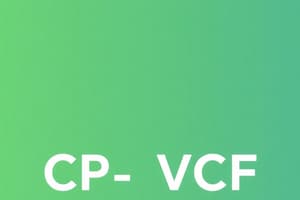Podcast
Questions and Answers
What is a key factor to consider when selecting a VMware Cloud platform?
What is a key factor to consider when selecting a VMware Cloud platform?
- User interface design
- Region availability (correct)
- Number of available applications
- Physical hardware specifications
Maintaining network security is not important for VCF deployments within VMware Cloud.
Maintaining network security is not important for VCF deployments within VMware Cloud.
False (B)
What should be planned for upgrades to manage potential issues effectively?
What should be planned for upgrades to manage potential issues effectively?
Rollback strategy
Proper _____ planning is essential to prevent performance bottlenecks.
Proper _____ planning is essential to prevent performance bottlenecks.
Match the following key considerations with their descriptions:
Match the following key considerations with their descriptions:
What type of processes are emphasized in disaster recovery planning?
What type of processes are emphasized in disaster recovery planning?
Efficient data management and backup strategies are essential within VCF deployments.
Efficient data management and backup strategies are essential within VCF deployments.
What is important to align with VCF deployment?
What is important to align with VCF deployment?
Security protocols and policies are directly integrated into the VMware _____ platform.
Security protocols and policies are directly integrated into the VMware _____ platform.
What is one of the main goals of resource optimization in a VCF environment?
What is one of the main goals of resource optimization in a VCF environment?
Which of the following is NOT a VMware Cloud platform where VCF can be deployed?
Which of the following is NOT a VMware Cloud platform where VCF can be deployed?
Monitoring the infrastructure in VCF involves tracking only CPU usage.
Monitoring the infrastructure in VCF involves tracking only CPU usage.
What is the role of automation tools like vRealize Automation in managing VCF?
What is the role of automation tools like vRealize Automation in managing VCF?
In deploying VCF, the process of defining the desired infrastructure is known as __________.
In deploying VCF, the process of defining the desired infrastructure is known as __________.
Match the following VCF components with their functions:
Match the following VCF components with their functions:
What is a key aspect to consider when upgrading VCF?
What is a key aspect to consider when upgrading VCF?
Regular maintenance tasks include patching and updating VCF components.
Regular maintenance tasks include patching and updating VCF components.
Name one tool that is crucial for performance monitoring in VCF.
Name one tool that is crucial for performance monitoring in VCF.
Configuration of VCF components is critical for optimal performance and __________.
Configuration of VCF components is critical for optimal performance and __________.
Which step follows planning in deploying VCF?
Which step follows planning in deploying VCF?
What is a primary benefit of leveraging the cloud's scalability in VCF deployments?
What is a primary benefit of leveraging the cloud's scalability in VCF deployments?
Deployment complexity is a minor challenge when deploying VCF on VMware Cloud.
Deployment complexity is a minor challenge when deploying VCF on VMware Cloud.
Name one aspect of disaster recovery planning in VCF deployments.
Name one aspect of disaster recovery planning in VCF deployments.
Leveraging automation tools is critical for __________ actions across the deployed VCF infrastructure.
Leveraging automation tools is critical for __________ actions across the deployed VCF infrastructure.
Match the following benefits of deploying VCF on VMware Cloud with their descriptions:
Match the following benefits of deploying VCF on VMware Cloud with their descriptions:
What is a common resource limitation that may affect VCF deployments?
What is a common resource limitation that may affect VCF deployments?
Ongoing effort is required to maintain the security of the VCF solution.
Ongoing effort is required to maintain the security of the VCF solution.
What does VCF stand for?
What does VCF stand for?
Efficient management of VCF resources often aligns with __________ requirements.
Efficient management of VCF resources often aligns with __________ requirements.
Which of the following is NOT directly mentioned as a benefit of deploying VCF on VMware Cloud?
Which of the following is NOT directly mentioned as a benefit of deploying VCF on VMware Cloud?
What is a primary benefit of deploying VMware Cloud Foundation on VMware Cloud?
What is a primary benefit of deploying VMware Cloud Foundation on VMware Cloud?
Using VMware vRealize Automation (vRA) is optional when deploying VCF on VMware Cloud.
Using VMware vRealize Automation (vRA) is optional when deploying VCF on VMware Cloud.
Name one key component of VMware Cloud Foundation.
Name one key component of VMware Cloud Foundation.
VCF management includes ongoing tasks such as monitoring, security management, and __________ optimization.
VCF management includes ongoing tasks such as monitoring, security management, and __________ optimization.
Match the following VMware Cloud Foundation components with their functions:
Match the following VMware Cloud Foundation components with their functions:
Which component provides centralized oversight for the VCF infrastructure?
Which component provides centralized oversight for the VCF infrastructure?
Provisioning VCF resources can be done directly through the VMware Cloud console.
Provisioning VCF resources can be done directly through the VMware Cloud console.
What does NSX provide in a VMware Cloud Foundation environment?
What does NSX provide in a VMware Cloud Foundation environment?
Managing allocated resources effectively is crucial for efficient use and __________.
Managing allocated resources effectively is crucial for efficient use and __________.
What is the role of built-in monitoring tools in VCF on VMware Cloud?
What is the role of built-in monitoring tools in VCF on VMware Cloud?
Flashcards
VMware Cloud Foundation (VCF)
VMware Cloud Foundation (VCF)
A set of software-defined data center (SDDC) components that automate the deployment, management, and operation of a virtualized data center.
VCF Deployment Platforms
VCF Deployment Platforms
VCF can be deployed on various VMware Cloud platforms, such as VMware Cloud on AWS, VMware Cloud on Azure, VMware Cloud on Dell EMC, and VMware Cloud on Google Cloud.
Planning VCF Deployment
Planning VCF Deployment
Defining the desired infrastructure, including the number and type of compute, storage, and network resources, along with security requirements and disaster recovery strategies.
Provisioning VCF
Provisioning VCF
Signup and view all the flashcards
Configuring VCF
Configuring VCF
Signup and view all the flashcards
Monitoring VCF
Monitoring VCF
Signup and view all the flashcards
Maintaining VCF
Maintaining VCF
Signup and view all the flashcards
Upgrading VCF
Upgrading VCF
Signup and view all the flashcards
VCF Management Tools
VCF Management Tools
Signup and view all the flashcards
Automation in VCF Management
Automation in VCF Management
Signup and view all the flashcards
VCF Security
VCF Security
Signup and view all the flashcards
Disaster Recovery for VCF
Disaster Recovery for VCF
Signup and view all the flashcards
Resource Optimization
Resource Optimization
Signup and view all the flashcards
Choosing the right VMware Cloud platform
Choosing the right VMware Cloud platform
Signup and view all the flashcards
Performance Requirements
Performance Requirements
Signup and view all the flashcards
Capacity Planning
Capacity Planning
Signup and view all the flashcards
Security Risk Mitigation
Security Risk Mitigation
Signup and view all the flashcards
Upgrade Rollback Strategy
Upgrade Rollback Strategy
Signup and view all the flashcards
Efficient Data Management
Efficient Data Management
Signup and view all the flashcards
VCF Adaptability and Scalability
VCF Adaptability and Scalability
Signup and view all the flashcards
What is VMware Cloud Foundation (VCF)?
What is VMware Cloud Foundation (VCF)?
Signup and view all the flashcards
Where can I deploy VCF?
Where can I deploy VCF?
Signup and view all the flashcards
What's the role of vRealize Automation (vRA) in VCF deployments?
What's the role of vRealize Automation (vRA) in VCF deployments?
Signup and view all the flashcards
How does managing VCF on VMware Cloud differ from traditional deployments?
How does managing VCF on VMware Cloud differ from traditional deployments?
Signup and view all the flashcards
What is vSAN?
What is vSAN?
Signup and view all the flashcards
How does NSX enable virtual networking in VCF?
How does NSX enable virtual networking in VCF?
Signup and view all the flashcards
What is the importance of vCenter Server in managing VCF?
What is the importance of vCenter Server in managing VCF?
Signup and view all the flashcards
Why is resource allocation crucial for VCF deployments?
Why is resource allocation crucial for VCF deployments?
Signup and view all the flashcards
What are the key benefits of deploying VCF on VMware Cloud?
What are the key benefits of deploying VCF on VMware Cloud?
Signup and view all the flashcards
How does security management differ between VCF on VMware Cloud and traditional deployments?
How does security management differ between VCF on VMware Cloud and traditional deployments?
Signup and view all the flashcards
VCF Automation
VCF Automation
Signup and view all the flashcards
VCF Security Importance
VCF Security Importance
Signup and view all the flashcards
VCF Disaster Recovery
VCF Disaster Recovery
Signup and view all the flashcards
Faster Deployment with VCF
Faster Deployment with VCF
Signup and view all the flashcards
Scale Resources with VCF
Scale Resources with VCF
Signup and view all the flashcards
Simplified VCF Management
Simplified VCF Management
Signup and view all the flashcards
VCF Deployment Complexity
VCF Deployment Complexity
Signup and view all the flashcards
VCF Cloud Integration
VCF Cloud Integration
Signup and view all the flashcards
Ongoing VCF Security
Ongoing VCF Security
Signup and view all the flashcards
Choosing the Right VCF Model
Choosing the Right VCF Model
Signup and view all the flashcards
Study Notes
Deploying VMware Cloud Foundation using VMware Cloud
- VMware Cloud Foundation (VCF) is a software-defined data center (SDDC) solution automating the deployment and management of a complete VMware vSphere, vSAN, NSX, and vCenter Server stack on a cloud platform.
- VCF deploys on VMware Cloud on AWS, VMware Cloud on Azure, VMware Cloud on Dell EMC, and VMware Cloud on Google Cloud.
- Deploying VCF involves planning, provisioning, and configuration.
- Planning defines the infrastructure (compute, storage, networking, security, disaster recovery). Pre-existing configurations or resources in the VMware Cloud platform may be needed.
- Provisioning uses VMware Cloud tools and APIs. VMware vRealize Automation (vRA) is required to interact with the underlying cloud provider's APIs.
- Configuration involves setting up vCenter Server, vSphere, NSX, and vSAN, ensuring optimal performance and security. VCF can be deployed in a vSphere-native or application-aware model.
Managing VMware Cloud Foundation Using VMware Cloud
- Managing VCF involves monitoring, maintaining, and upgrading components and securing VCF.
- Monitoring tracks performance (CPU, memory, storage) using tools like vRealize Operations Manager and built-in monitoring.
- Maintenance includes patching, updating components, and managing resources. Stability and security are ensured.
- Upgrading involves careful planning – migrating VMs, configuring dependencies, and minimizing downtime.
- Centralized management is through VMware Cloud platform management tools integrating with vRealize. Automation tools like vRealize Automation streamline workflows (deployments and configurations).
- Security integrates with the underlying cloud provider's security features. Network security and access controls are essential.
- Disaster recovery planning mitigates downtime from errors/failures.
- Resource optimization reduces operating costs by efficient usage of CPU, memory, and storage. The VMware Cloud console simplifies VCF management by providing a unified view of all components. vCenter Server, vSphere, and related tools manage VCF functionalities—virtual machines, networking, and storage.
Key Considerations for Deployment and Management
- Select the appropriate VMware Cloud platform based on region availability, cost, and performance needs.
- Define specific performance requirements to meet business needs.
- Effective capacity planning prevents performance bottlenecks (CPU and memory).
- Identify and mitigate security risks throughout deployment and monitoring.
- Plan a rollback strategy for upgrades.
- Ensure efficient data management and backups. Support future needs through adaptability and scalability. Adhere to VMware support guidelines.
- Allocate resources for deployment, maintenance, and upgrades. Align VCF deployment with business goals. There are inherent benefits such as automated provisioning, scalable resources, and managed services, from the underlying cloud platform. Deployment can be complex, requiring detailed planning and expertise. Knowledge of the underlying cloud provider, APIs, and limitations is necessary. Security policies must match the underlying provider’s security.
Key Components and Considerations
- vSphere is the hypervisor for virtual machines.
- vSAN manages distributed storage.
- NSX is a software-defined networking solution.
- vCenter Server centralizes vSphere management in the cloud.
- vRealize Automation (vRA) automates VCF deployments and management by interacting with the underlying cloud platform.
- Effective resource allocation is critical for performance and efficiency.
- Automation is crucial for streamlining tasks.
- Security policies and configurations are vital. Disaster recovery strategies are important for system availability.
Benefits of Deploying VCF on VMware Cloud
- Automated infrastructure provisioning significantly reduces deployment time.
- Scalable cloud resources allow for rapid scaling.
- The VMware Cloud console simplifies operations and maintenance.
- Streamlined workflows reduce manual intervention.
- Potential cost savings are possible through pay-as-you-go or reduced administrative overhead.
- Reliable access to needed resources for VCF operations.
Challenges of Deploying VCF on VMware Cloud
- Deployment complexity requires planning and expertise.
- Integrating VCF with the underlying cloud infrastructure can be challenging, needing deep understanding of the provider's APIs and limitations.
- Maintaining VCF security requires ongoing effort and configuration management.
- Shared cloud provider resource limits can be a constraint during peak usage.
- Choosing the right VCF deployment model is critical, because the choice affects the solution's usability and manageability.
Studying That Suits You
Use AI to generate personalized quizzes and flashcards to suit your learning preferences.




